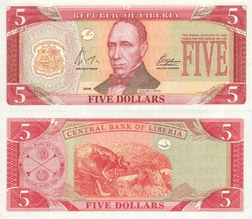Liberian dollar
| Liberian dollar | |
|---|---|
|
A current $5 banknote | |
| ISO 4217 code | LRD |
| Central bank | Central Bank of Liberia |
| Website |
cbl |
| User(s) |
|
| Inflation | 6.9% |
| Source | The World Factbook , 2012 est. |
| Subunit | |
| 1/100 | cent |
| Symbol | L$ |
| Coins | 5, 10, 25, 50 cents, 1 dollar [1] |
| Banknotes | 5, 10, 20, 50, and 100 dollars |
The dollar (currency code LRD) has been the currency of Liberia since 1943. It was also the country's currency between 1847 and 1907. It is normally abbreviated with the dollar sign $, or alternatively L$ or LD$ to distinguish it from other dollar-denominated currencies. It is divided into 100 cents.
Exchange rate
| Current LRD exchange rates | |
|---|---|
| From Google Finance: | AUD CAD CHF EUR GBP HKD JPY USD |
| From Yahoo! Finance: | AUD CAD CHF EUR GBP HKD JPY USD |
| From XE: | AUD CAD CHF EUR GBP HKD JPY USD |
| From OANDA: | AUD CAD CHF EUR GBP HKD JPY USD |
| From fxtop.com: | AUD CAD CHF EUR GBP HKD JPY USD |
| From Currency.Wiki: | AUD CAD CHF EUR GBP HKD JPY USD |
First dollar


The first Liberian dollar was issued in 1847. It was pegged to the US dollar at par and circulated alongside the US dollar until 1907, when Liberia adopted the British West African pound, which was pegged to sterling.
Coins
In 1847, copper 1 and 2 cents coins were issued and were the only Liberian coins until 1896, when a full coinage consisting of 1, 2, 10, 25 and 50 cents coins were introduced. The last issues were made in 1906.
Banknotes
The Treasury Department issued notes between 1857 and 1880 in denominations of 10 and 50 cents, 1, 2, 3, 5 and 10 dollars.
Second dollar
United States currency replaced the British West African pound in Liberia in 1935 . Starting in 1937, Liberia issued its own coins which circulated alongside US currency.
The flight of suitcase-loads of USD paper in the economic collapse following the April 12, 1980 coup d'état created a currency shortage, which was only exacerbated when the government began minting $5 coins. Unfortunately the 7-sided coins were the same size and weight as the one-dollar coin; this similarity was frequently abused by traders.
In the late 1980s the coins were largely replaced with a newly designed $5 note modeled on the US greenback ("J. J. Roberts" notes). The design was modified during the 1990-2004 civil war to ostracize notes looted from the Central Bank of Liberia. This effectively created two currency zones -- the new "Liberty" notes were legal tender in government-held areas (primarily Monrovia), while the old notes were legal tender in non-government areas. Each was of course illegal in the other territory.
Following the election of the Charles Taylor government in 1997 a new series of banknotes dated 1999 was introduced on March 29, 2000.
Coins
In 1937, coins were issued in denominations of ½, 1 and 2 cents. These were augmented in 1960 with coins for 1, 5, 10, 25 and 50 cents. A $1 coin was issued the following year. Five-dollar coins were issued in 1982 and 1985 (see above). According to the 2009 Standard Catalog of World Coins (Krause Publications, Iola, WI), numerous commemorative coins (featuring U.S. Presidents, dinosaurs, Chinese Lunar-Zodiac animals, etc.) in denominations ranging from 1 to 2500 Dollars have been issued beginning in the 1970s through the present.
Banknotes
Five-dollar notes were introduced in 1989 which bore the portrait of J. J. Roberts. These were known as "J. J." notes. In 1991, similar notes were issued (see above) which replaced the portrait with Liberia's arms. These were known as "Liberty" notes.
On 29 March 2000, the Central Bank of Liberia introduced a new “unified” currency, which was exchanged at par for “J. J.” notes and at a ratio of 1:2 for “Liberty” notes. The new banknotes each feature a portrait of a former president. These notes remain in current use, although they underwent a minor redesign in 2003, with new dates, signatures, and the CENTRAL BANK OF LIBERIA banner on the back.[2]
| 1999 series | ||||||||
|---|---|---|---|---|---|---|---|---|
| Images | Value | Background color | Description | Date of | ||||
| Obverse | Reverse | Obverse | Reverse | Watermark | first series | Issue | ||
| $5 | Red | President Edward J. Roye | Woman harvesting rice | Seal of Liberia | 1999 | March 29, 2000 | ||
| $10 | Blue | President Joseph J. Roberts | Rubber tapper | Seal of Liberia | 1999 | March 29, 2000 | ||
| $20 | Maroon | President William V. S. Tubman | Young men by the road with scooters | Seal of Liberia | 1999 | March 29, 2000 | ||
| $50 | Pink/Purple | President Samuel K. Doe | Worker on a palm plantation | Seal of Liberia | 1999 | March 29, 2000 | ||
| $100 | Green | President William R. Tolbert, Jr. | Market woman and her child | Seal of Liberia | 1999 | March 29, 2000 | ||
See also
References
- ↑ Currency from the Central Bank of Liberia. Accessed 2008/03/19
- ↑ Linzmayer, Owen (2012). "Liberia". The Banknote Book. San Francisco, CA: www.BanknoteNews.com.
- Krause, Chester L., and Clifford Mishler (1991). Standard Catalog of World Coins: 1801–1991 (18th ed.). Krause Publications. ISBN 0873411501.
- Pick, Albert (1994). Standard Catalog of World Paper Money: General Issues. Colin R. Bruce II and Neil Shafer (editors) (7th ed.). Krause Publications. ISBN 0-87341-207-9.
External links
| ||||||||||||||||||||||||||||||||||||||
| ||||||||||||||||||||||
